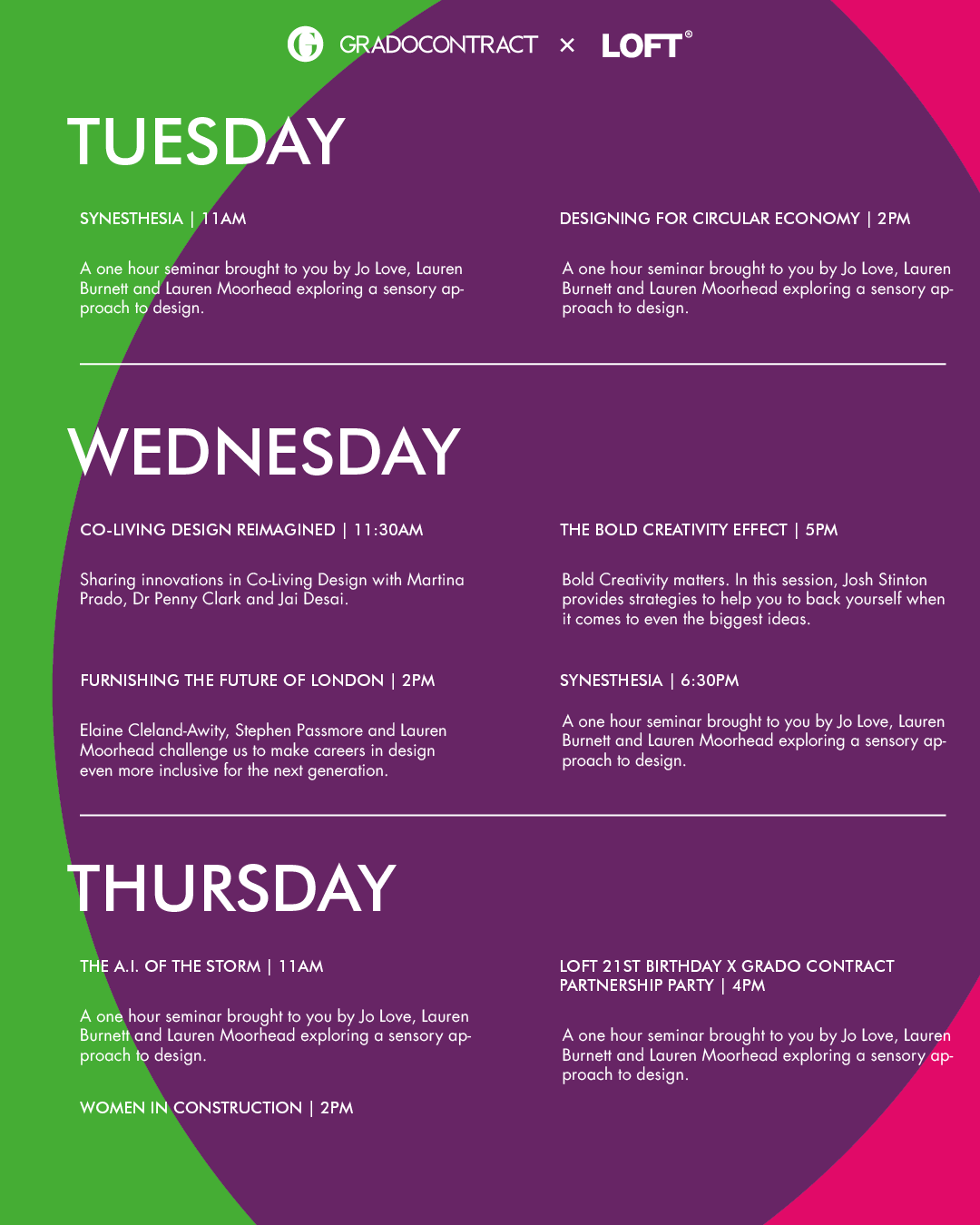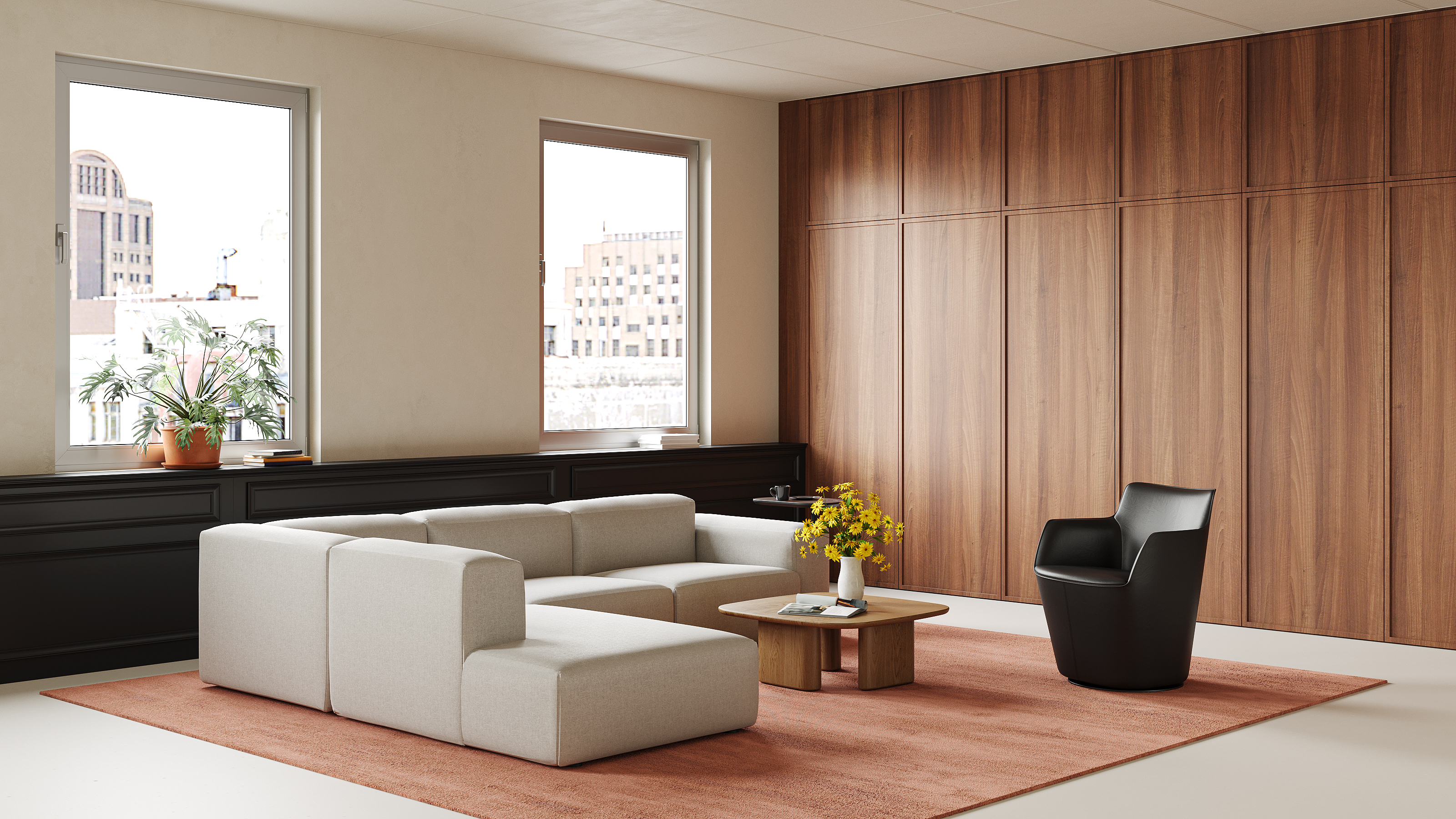GRADOCONTRACT and LOFT's expedition at CDW 2024 remarkably kicks off with an exploration of the innovative synesthesia design approach, symbolizing an assertive stride towards harnessing cross-sensory mapping and interconnected sensory dimensions and underscoring our commitment to propelling contemporary design practices forward. Specifically, we extend to pioneering creations such as the Vase Lounge Chair. This exemplifies our effort to push the boundaries of design innovation by harnessing the capabilities of a repetitively trained AI data model. Embracing avant-garde approaches including synesthesia design principles, we propose a compelling and immersive space solution that reflects a dedication to creating more connected visual storytelling and achieving impressive space recognition.
 CDW2024_AGENDA OVERVIEW
CDW2024_AGENDA OVERVIEW
The inclusion of synesthesia introduces a distinct dimension to the creative process, enabling designers to forge products that engage users in novel and immersive ways by untangling the intricate relationship between sensory stimuli and design outcomes. The synesthetic approach enriches user experiences by constructing a multisensory framework that transcends traditional design methods. Designers can devise products that captivate users holistically, evoking emotional responses and fostering enduring connections, thus paving the way for fresh experimentation and innovative design solutions. In fact, synesthesia is a neurological condition wherein the perception of a stimulus in one sensory modality leads to automatic experiences in a second, unstimulated modality. There are approximately 80 variations of sense associations, with each synesthete's experience being distinctive and idiosyncratic. Synesthesia is closely linked with heightened creativity, revealing cross-modal associations that offer insights into human consciousness. Creative individuals often exhibit a heightened tolerance for inconsistency and possess an adeptness at comprehending metaphorical connections. Cross-sensory mapping facilitates the facile association of distinct sensory dimensions among themselves. Illustrative examples include the association between shapes and words, or between body movements and rhythms. Inspiring multisensory design examples include "Essence in Space" by Chang Hee Lee, which establishes synesthetic connections between music and fragrances, "REIFY" by Allison Wood and Kei Gowda, involving the transformation of music into 3D printed sculptures, and "Lickestra" by Emilie Baltz, Carla Diana, and Arone Dyer, which combines music and taste through a musical licking performance employing conductive ice cream cones. (Reference: Sevi Merter, 2017 Synesthetic Approach in the Design Process for Enhanced Creativity and Multisensory Experiences, The Design Journal, 20)
— DAY1 SYNESTHESIA —
.png)
Credit_Richard Bailey&Jo Love_LINKEDIN POST
.png)
Credit_Jo Love_LINKEDIN POST
— DAY2 "That Wasn't a Talk It Was an Experience" —
.png)


The Vase lounge chair design ingeniously embodies the principles of synesthesia, a neurological condition where stimulation of one sensory pathway leads to experiences in another. By leveraging AI-driven optimization, generative algorithms, and human expertise, the Vase chair creates a truly multisensory experience. Primarily, the Vase's design process embodies synesthesia through the amalgamation of various sensory elements. The chair's minimalist and elegant curves denote a tactile sense of comfort and sophistication, resonating with the principles of touch. Additionally, the incorporation of generative algorithms infused the chair's design with an inherent visual appeal, stimulating the user's sense of sight through its precise and elegant lines. The AI-assisted features further exemplify the synesthetic approach. The chair's self-resetting base with rotation functionality not only adds a functional aspect but also stimulates the user's sense of convenience and ease, thus appealing to the tactile and practical senses. Furthermore, the Vase's symbolism of delicate flower arrangements adds an extra layer of emotional and aesthetic symbolism, appealing to the user's sense of artistic appreciation.
We have noted the potential of office renovations to attract younger generations back to traditional work models, emphasizing the importance of sophisticated experiential space design through visual manipulations. It suggests that effective makeover schemes can greatly influence employee satisfaction and productivity, beyond just furniture placement and aesthetic appeal. The concept of mixed qualities and hybrid spaces is highlighted, emphasizing the strategic fusion of featured elements to create a memorable experience. Interior designers are prompted to blend elements from various environments, such as hospitality, retail, and residential spaces, to craft a unique and appealing ambiance that resonates with diverse preferences and expectations.
The contemporary embrace of new neutrals and quiet luxury in workplace design, underlining the significance of visual merchandising and the strategic use of specific color palettes to convey desired attitudes and moods. It stresses the importance of colors in creating an atmosphere of relaxation and conveying specific emotions or associations with different industries. Embracing the concept of quiet luxury, the article suggests that creating an atmosphere of understated elegance and sophistication can be achieved through a strategic choice of neutral color palettes and the use of high-quality materials. The curated visual guide and visual storytelling are highlighted as a means of creating a strong and persistent brand identity, particularly in the context of offline and online consumer experiences.
The concept of mixed qualities and hybrid spaces is presented as a strategic fusion of elements from hospitality, retail, and residential spaces to create a memorable experience. The convergence of these distinct environments is exemplified through real-world cases. For instance, the Bibu Pet Store in Guangzhou draws inspiration from the futuristic visual motifs of "2001: A Space Odyssey," establishing a compelling connection with Stanley Kubrick's iconic visual narratives. This approach to interior design creates a captivating atmosphere that immerses visitors in an unforgettable experience. Furthermore, the Web-3 Café, unveiled during Paris Fashion Week, showcases an artsy installation that reinterprets a metaverse videogame, creating a breathtaking "phy-digital" experience, merging digital and virtual retail into one captivating display. The café embodies an off-white, forest green, and slate blue color palette, enhanced by mesmerizing LED lighting and retro-futuristic furniture.
Designers Introduction